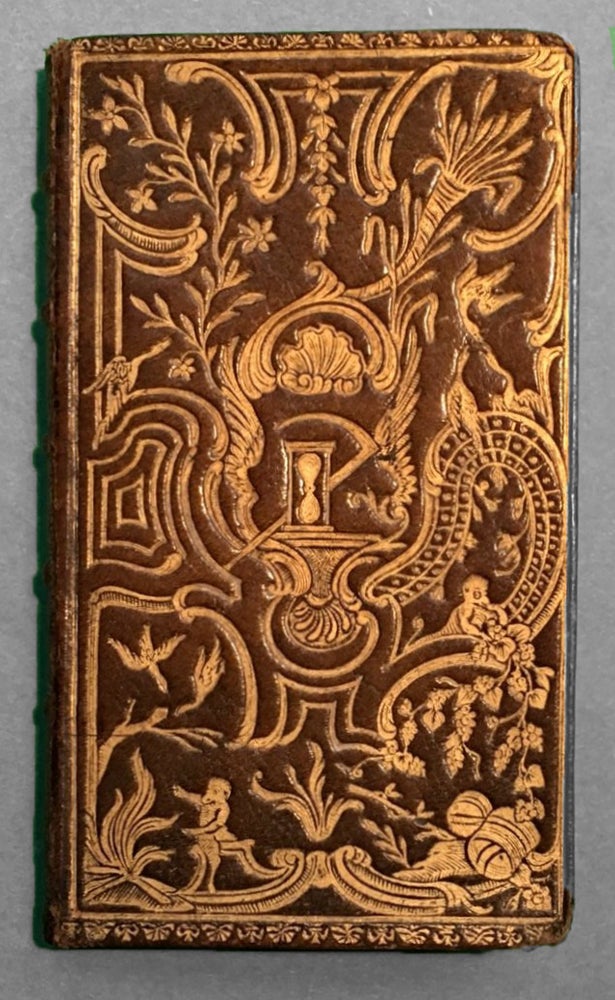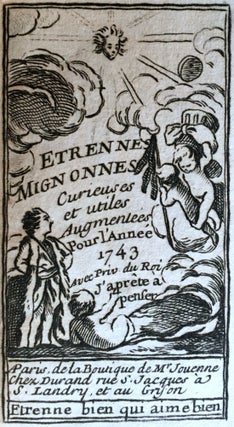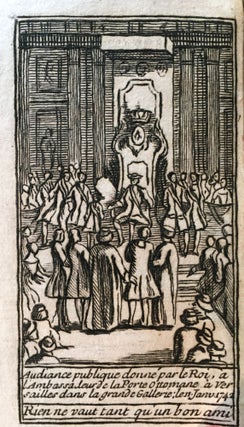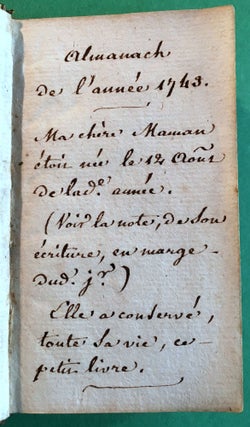Etrennes mignonnes Curieuses et utiles Augmentées pour l’Année 1743. Paris: de la boutique de M. Jouenne chez Durand rue S. Jacques à S. Landry et au Grison, [1742/43].
32mo (binding size 99 x 57 mm). [64] pp. Engraved frontispiece, additional engraved title, double-page engraved map of France at end. Contemporary emblematic binding of gold-blocked brown goatskin, both covers with a panel stamp incorporating at center a scythe and an hourglass, framed in curving lines, with drawer-handle ornaments, flowering plants, a cornucopia, birds, a grapevine, and a monkey warming his hands at a fire; pink satin liners, gilt edges (small chip to head of spine, corners scuffed). Provenance: later 18th-century marginal note “Ma naissance” next to the date 12 August on calendar page for August; late 18th-century inscription at front identifying the note as that of the writer’s mother, born 12 August 1743, and stating that she kept this little book her entire life.
A long-running Paris almanac, in a contemporary binding with an unusual asymmetrical rococo panel-stamped decor, mixing emblematic or chinoiserie elements and Western memento mori motifs. This year’s issue has Ottoman relevance.
The Etrennes mignonnes were published, with changing subtitles, from 1716 to ca. 1845. The engraved title and frontispiece varied from year to year (up to 1750, after which none were used), and the map alternated between an ecclesiastical, civil, or military map of France, or a map of the Paris region. This edition has a special frontispiece showing the audience given by the King to the Ottoman ambassador (Mehmed Said Effendi), in January 1742: Sultan Mahmud I had sent the ambassador to Paris in 1742, as a demonstration of friendship following France’s mediation on behalf of the Ottomans after the Austro-Turkish war of 1737-39. The text is crammed with the usual densely printed lists of royal families of Europe, officials in various French departments and jurisdictions, Church clerics, and knights, and brief chronologies and miscellaneous facts.
These include a list of the luxurious gifts sent by the king to the sultan: prize examples of French craftsmanship and taste, such as an extraordinary silver chandelier, inlaid furniture, splendid “sophas,” 2 mirrors with gilt-bronze frames depicting the Ottoman empire, carpets, inlaid coffrets, and an entire organ. Also listed are the gifts presented to the Grand Vizier, the ambassador, and members of his retinue (including a “large brilliant diamond” for the ambassador).
Grand-Carteret 107; cf. Cohen-de Ricci 51. On the royal gifts, see Fatma Müge Göçek, East Encounters West: France and the Ottoman Empire in the Eighteenth Century (Oxford & New York, 1987), pp. 60-61 & 142-144 (citing only later sources of information on the gift exchanges).
Price: $1,600.00




